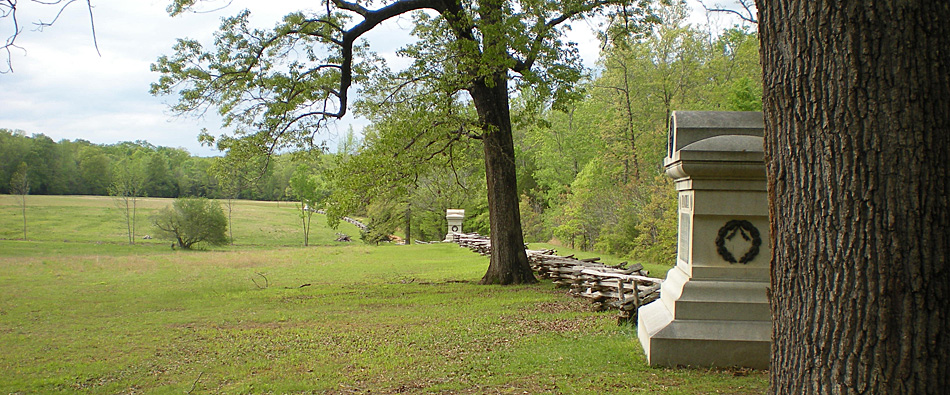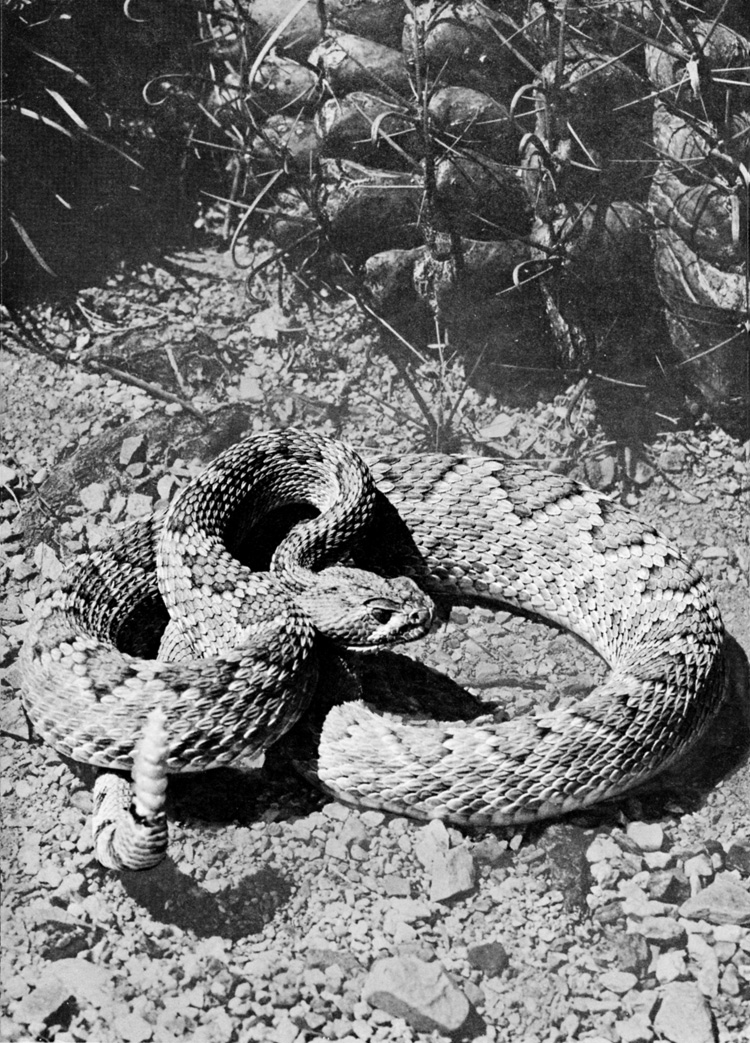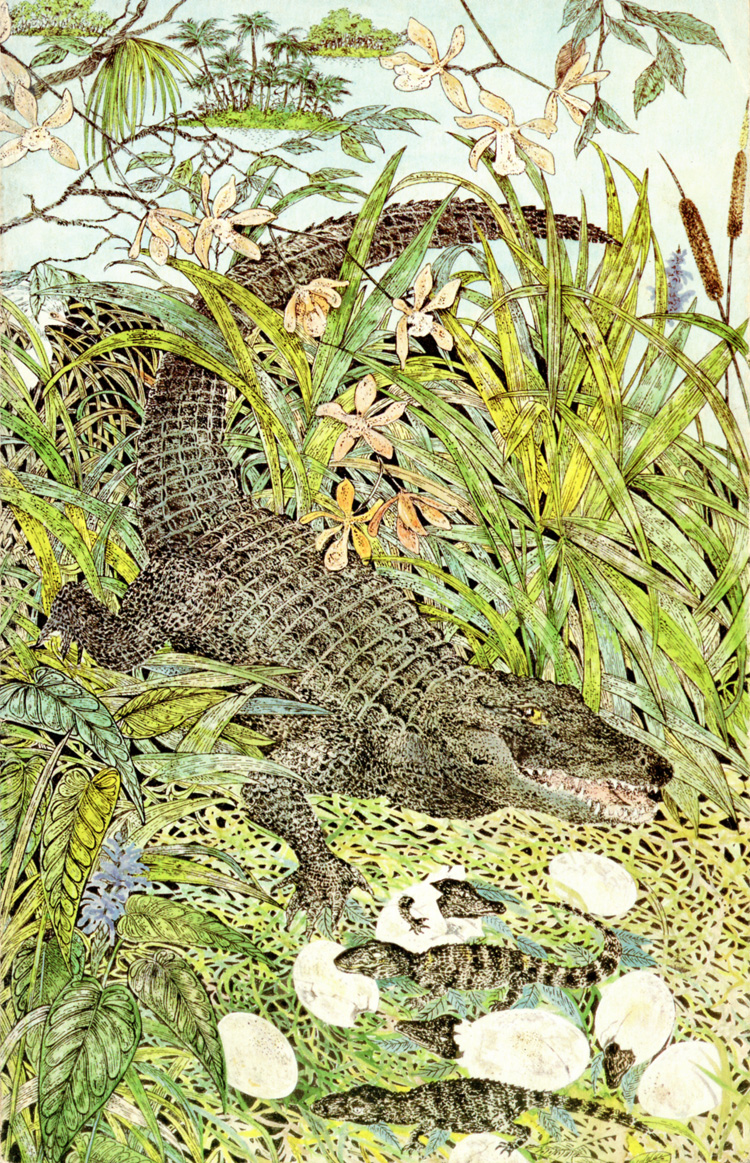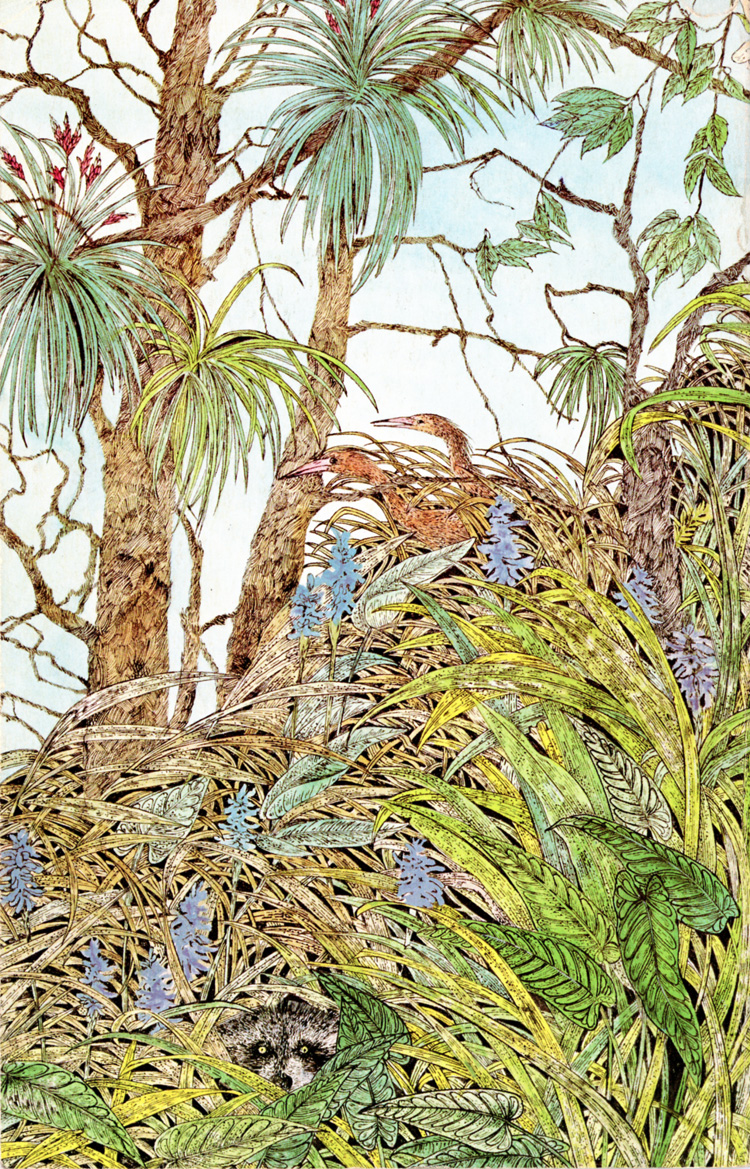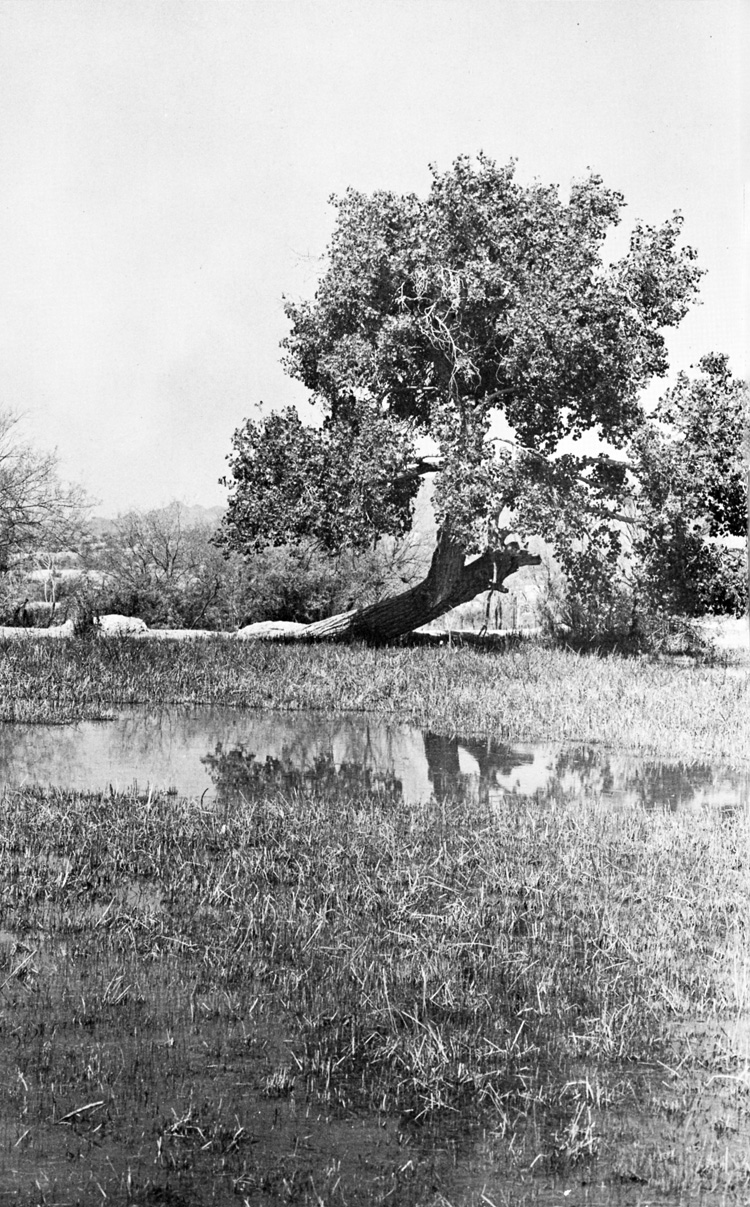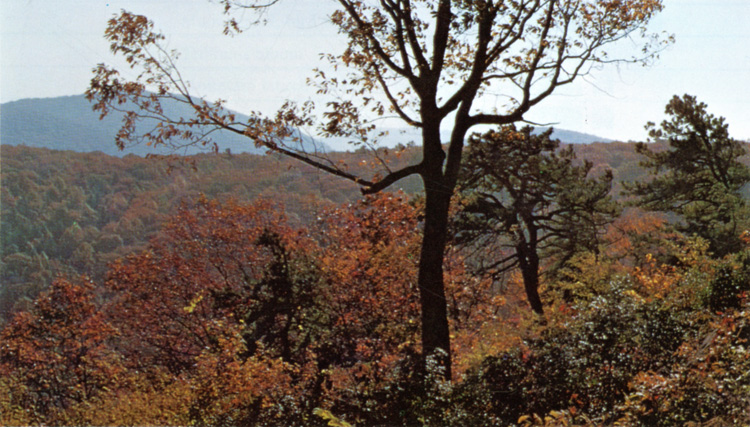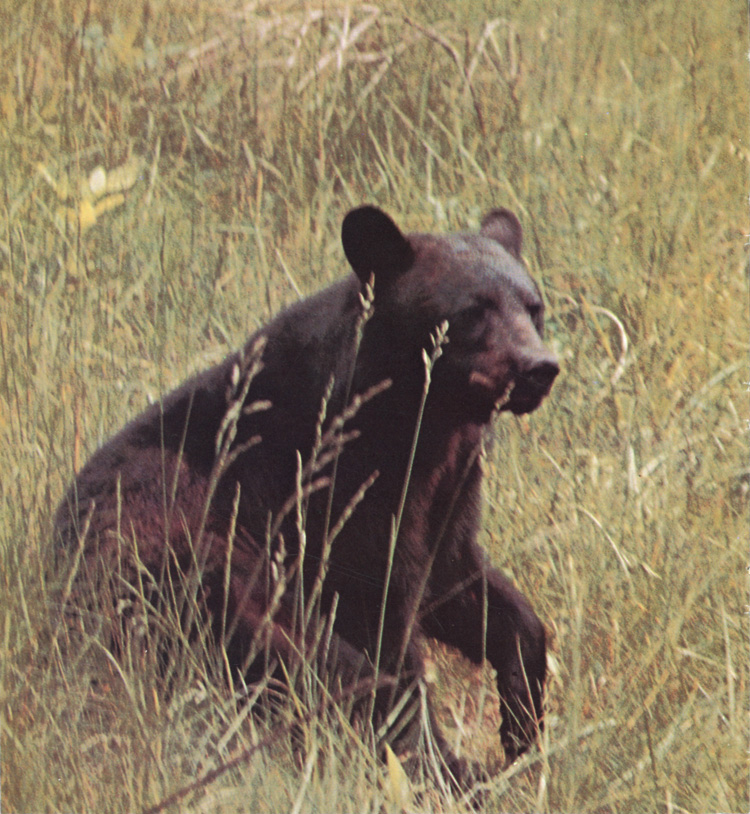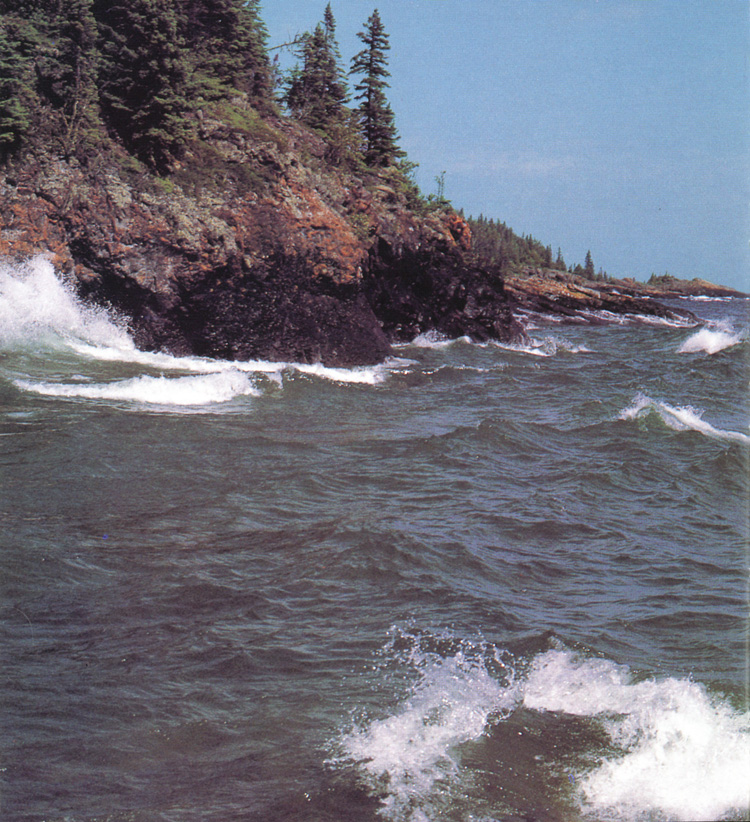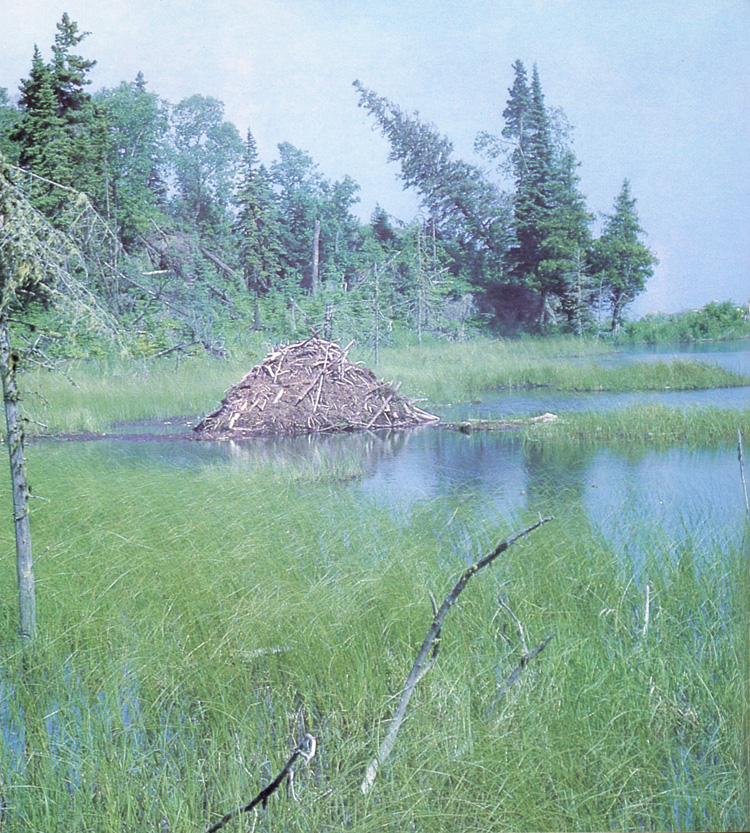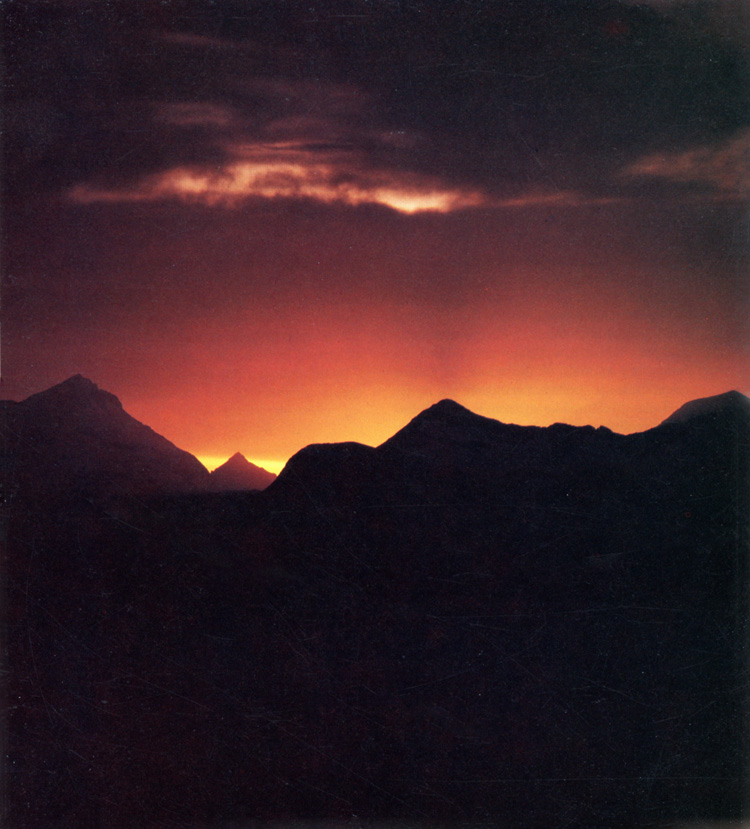|
The National Park Service commissioned Charley Harper to produce 10 posters
commemorating the biological diversity represented by our national parks.
Produced between the late 1970s and early 1990s, throughout this month's historical
photos and art collection is a display of all 10 Charley Harper NPS posters.
This month we are also highlighting the illustrations of Walter Weber, the National Park Service's Chief Scientific Illustrator
from 1936-1941. Walter Weber went on to become the staff artist and naturalist
for the National Geographic Society, whose illustrates graced the pages of
National Geographic from 1949-1971. These illustrations were taken from
Fading Trails: The Story of Endangered American Wildlife (1942).
The remaining photographs this month were extracted from the National Park Service's
Natural History Handbook series.
Historical Photos and Art

The Sierra Range
(Artwork by Charley Harper)
(click image for a larger size)
|
|
At the bottom, on a light purple background, white text reads the Sierra Range;
black text reads granite cliffs, giant trees, waterfalls; nature's scale is massive at
Yosemite, Sequoia, and Kings Canyon National Parks in California's Sierra Nevada;
National Park Service, U.S. Department of the Interior. A diagonal line of seven
colorful birds perching on a branch in front of a wide brown tree trunk leads from
the top left of the illustration toward the center, where a brown deer with white
spots looks to the right. A yellow and black butterfly flies off the top next to an
upside-down squirrel chewing on a pine cone. More birds travel from right to left,
with gray mountains and a large white waterfall in the background. A striped snake,
a line of small white and yellow birds, two quail, and a chipmunk hide among multicolored
wildflowers, green ferns, and brown oak leaves at the bottom. A raccoon
peers over a gray boulder next to a group of white flowers with three green leaves
each along the center left.
|

Olympic National Park
Mount Olympus, from Hoh-Soleduck Divide; Blue Glacier in the upper left.
(from Olympic National Park Natural History Handbook Series No. 1)
|

Olympic National Park
Draperies of clubmoss hang from the limbs in the rain forest.
(from Olympic National Park Natural History Handbook Series No. 1)
|

Olympic National Park
Numerous small islands and rocks add to the scenic beauty of the coast along the Olympic ocean strip. This is Abbey Island.
(from Olympic National Park Natural History Handbook Series No. 1)
|

Hawaii Volcanoes
(Artwork by Charley Harper)
(click image for a larger size)
|
|
Along the left side, on a bright red background, white text reads Hawaii Volcanoes;
black text reads lava flowing toward the sea often surrounds higher areas, creating
undisturbed islands called kipukas; visit Hawaii Volcanoes National Park to see
these extraordinary refuges of plants and animals; National Park Service, U.S.
Department of the Interior. At the top left of the illustration, a brown and black
butterfly flies downward across a blue sky with wispy white lines representing
clouds. Four shapes flow downward, changing from light orange to darker orange
and red. In the middle of these shapes is a collection of five colorful birds including
a goose; assorted tropical green leaves; lilac, yellow, and white flowers; and yellow
and red berries. A rough gray background surrounding the flowing shapes sits
above a horizontal dark gray area with a patchwork of light gray lines, ending at
white waves in a blue sea.
|

Badlands National Park
The Badlands contain a myriad of erosional forms.
(Photo by South Dakota State Highway Commission, from Badlands National Park Natural History Handbook No. 2)
|

Badlands National Park
A young prairie dog at his den entrance.
(Photo by Carl P. Koford, from Badlands National Park Natural History Handbook No. 2)
|

Badlands National Park
The rocks exposed in the badlands are approximately 40 million years old.
(NPS Photo, from Badlands National Park Natural History Handbook No. 2)
|

The Coral Reef
(Artwork by Charley Harper)
(click image for a larger size)
|
|
Along the left side, on a black background, white text reads the coral reef; Virgin
Islands National Park, Biscayne, Fort Jefferson and Buck Island Reef National
Monuments; National Park Service, U.S. Department of the Interior. Top dark blue
creates an underwater color explosion scene full of sea life including yellowtail
snapper, blue striped grout, bright blue tan, band tail puffer, Grouper, ballyhoo,
blue parrotfish sea turtles, green w/ red tail stoplight parrotfish, immature
parrotfish, black and white striped zebra fish, eagle ray, clownfish, barracuda,
moray eel, squid, yellowhead fish, brittle star, sea anemone, sponge, spiny lobster,
and trumpet fish.
|

Great Smoky Mountains National Park
The Chimney Tops as seen from the transmountain road. This most photographed landmark towers above the head of the Sugarlands Valley. Many species of trees make up the dense forests, here and throughout the lower and middle altitudes.
(Tennessee Conservation Department Photo, from Great Smoky Mountains National Park Natural History Handbook No. 5)
|

Great Smoky Mountains National Park
The evergreen leaves of this catawha rhododendron (top) are wider and not as sharply pointed as the leaves of the rosebay or great white rhododendron. Temperatures as low as 20° below zero have been recorded in plades where these shrubs grow. Three petals, three sepals, and three leaves = trillium (bottom). This is the erect white species whose local name is "Stinking Willy".
(Tennessee Conservation Department photo (top), NPS Photo (bottom), from Great Smoky Mountains National Park Natural History Handbook No. 5)
|
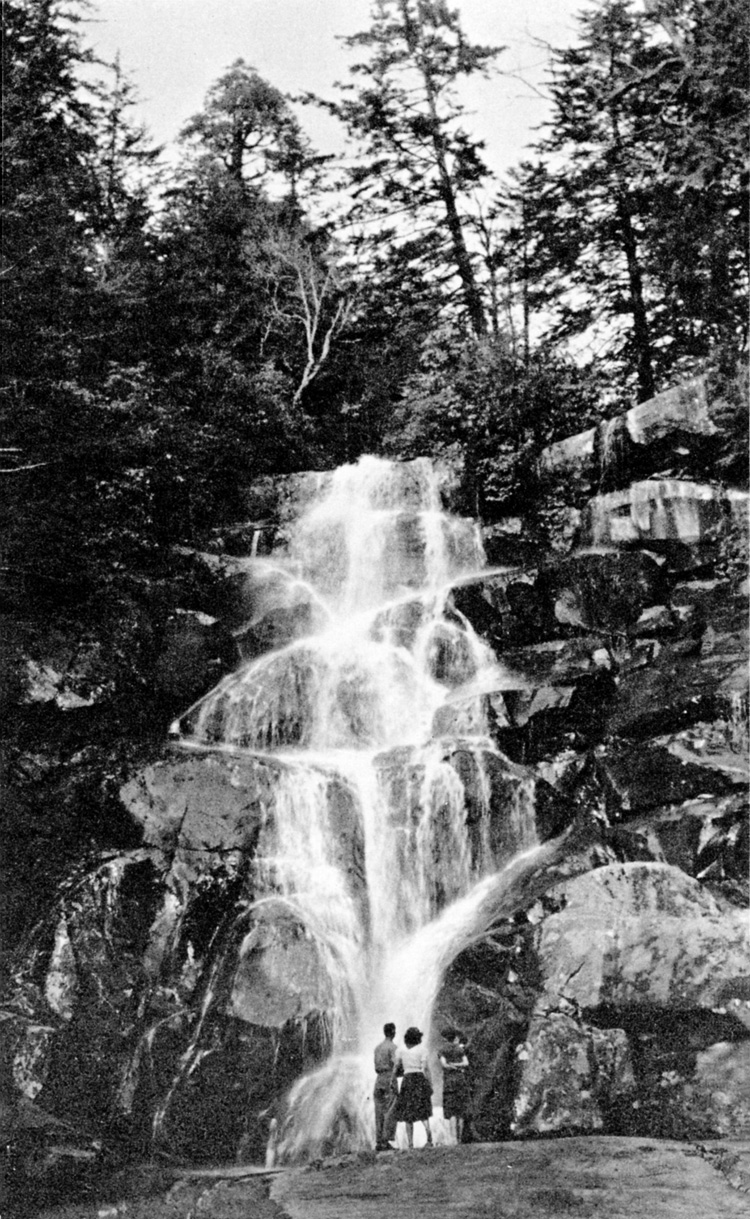
Great Smoky Mountains National Park
One of the finest waterfalls in the park is Ramsey Cascades. It is reached by a trail which passes through a splendid forest of giant trees.
(NPS Photo, from Great Smoky Mountains National Park Natural History Handbook No. 5)
|

Atlantic Barrier Islands
(Artwork by Charley Harper)
(click image for a larger size)
|
|
Along the left side, on a gray background, white text reads Atlantic Barrier Islands;
black text reads shifting sands and tides, sunken forests, marine life, and birds,
birds, birds....visit these wildlife-rich barrier islands: Fire Island, Assateague, Cape
Hatteras, Cape Lookout, Cumberland Island, and Canaveral National Seashores
and Biscayne National Park; National Park Service, U.S. Department of the Interior.
Starting at top a grey sky covers the entire width of the image. In the skyline a
group of birds can be seen flying to the left of the illustration. Just under them
three bands of gray, light blue and green stretch across the entire image. A thick
band of dark grey stretches across the illustration next. On that band we see
pointed leaves drawn in black outline stacked on top of each other in three rows.
Brown now represents the sand in this illustration. We see a large piece of
driftwood in the middle. Around it are many types of black and white and brown
and white birds. Some are gulls.
|
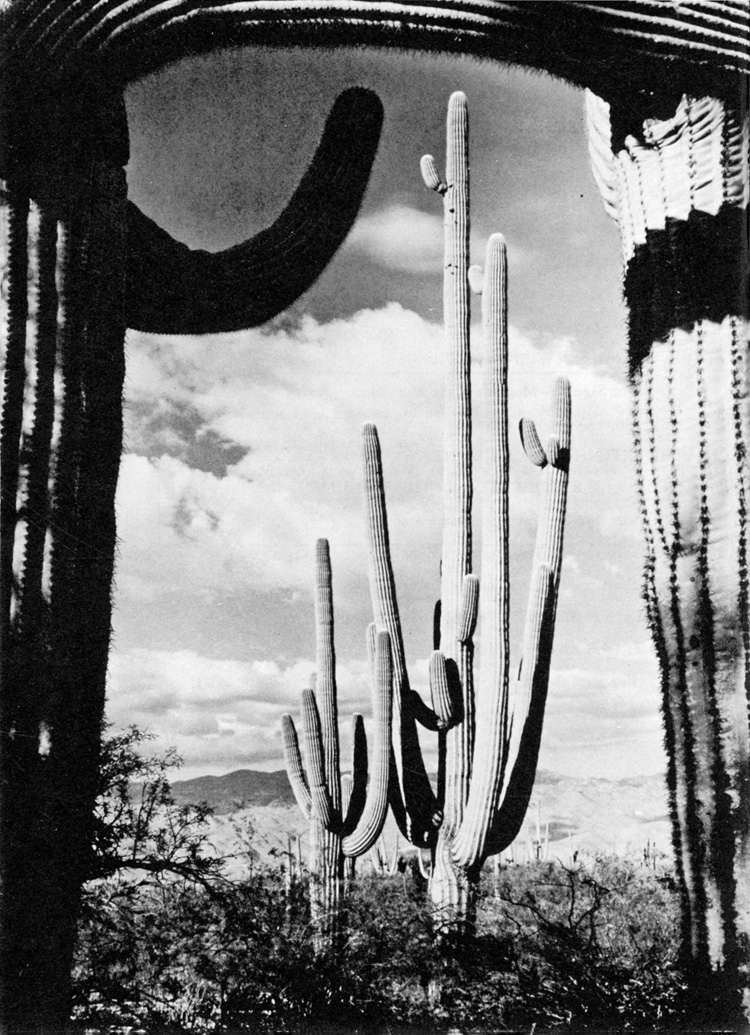
Saguaro National Park
Stately saguaros provide a wealth of vista for the photographer.
(NPS Photo, from Saguaro National Monument Natural History Handbook No. 5)
|
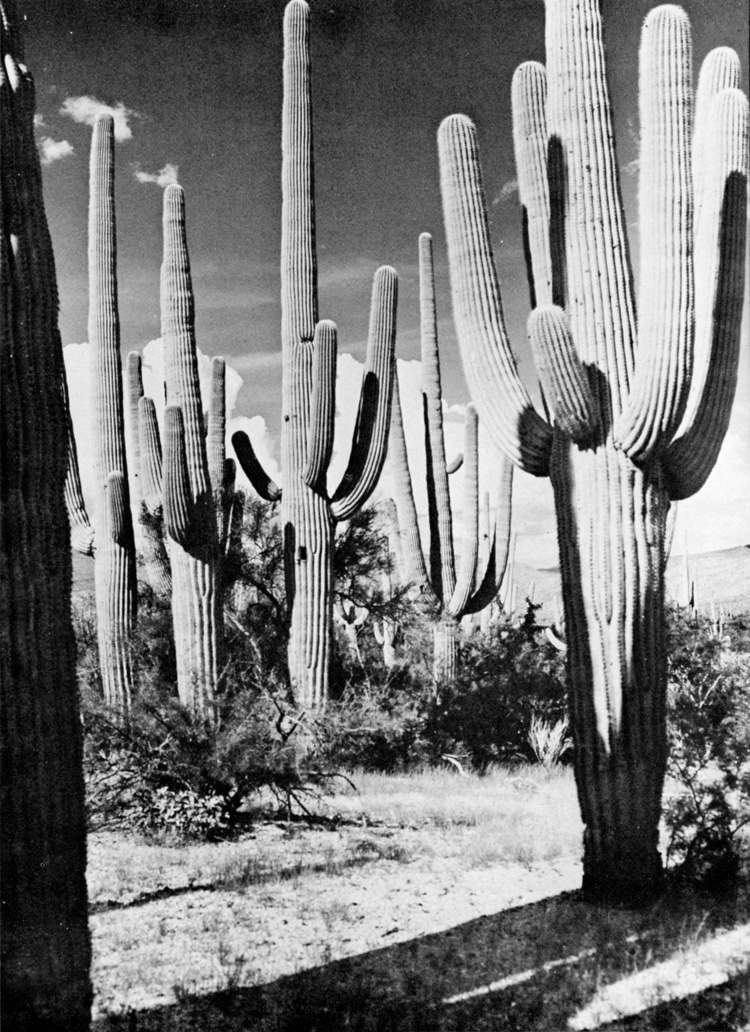
Saguaro National Park
The Cactus Forest has been called a wilderness of unreality.
(NPS Photo, from Saguaro National Monument Natural History Handbook No. 5)
|

Glacier Bay, Alaska
(Artwork by Charley Harper)
(click image for a larger size)
|
|
Along the left side, on a dark gray background, blue text reads Glacier Bay, Alaska;
white text reads colossal Alaskan glaciers grind relentlessly toward the sea; in this
primeval wilderness, the land, water, and air abound with wild creatures that
delight the eye; National Park Service, U.S. Department of the Interior. At the top
left of the illustration, gray mountains stand behind a glacier terminating in the
ocean with floating icebergs while multiple bird species fly overhead. A large black
whale tail dominates the center of the image with a line of gray seals underneath.
A yellow butterfly, fish, squirrel, Canada goose, and more birds surround the tail.
Underneath, a bald eagles looks to the right toward a fishing and a swimming bear,
pink and yellow flowers, and a wood duck. A gray shoreline with wading birds fades
down to a forest of green leaves of assorted shapes with birds, blooming flowers,
and berries scattered throughout.
|
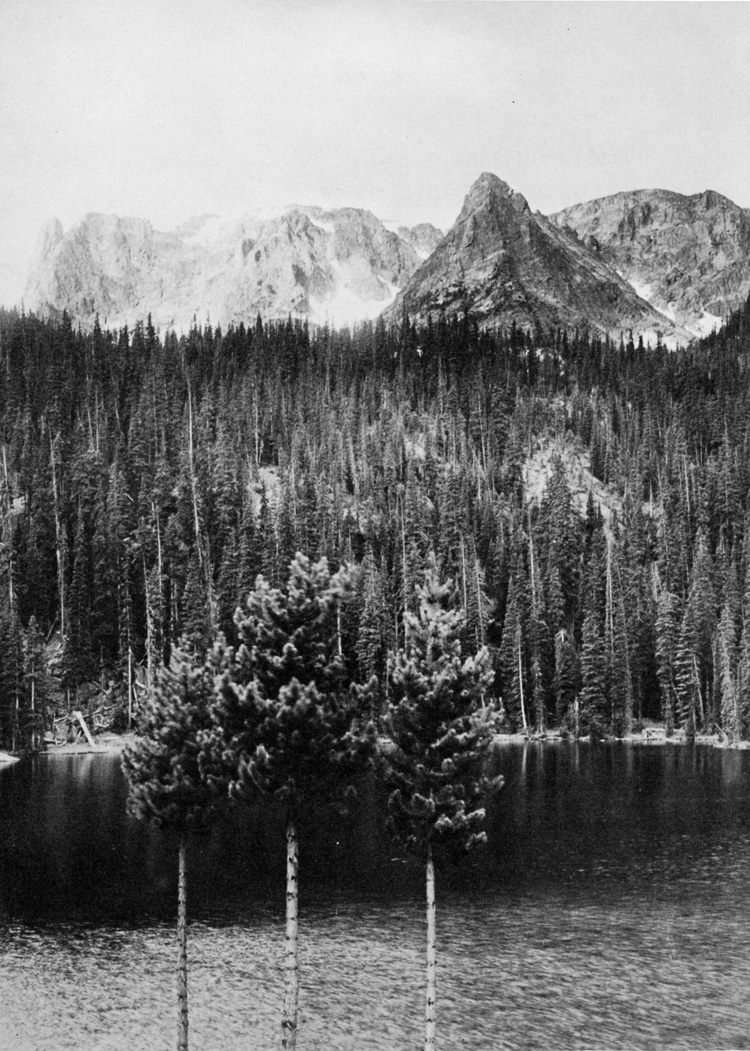
Rocky Mountain National Park
Notchtop and Little Matterhorn from Fern Lake.
(NPS Photo, from Rocky Mountain National Park Natural History Handbook No. 3)
|
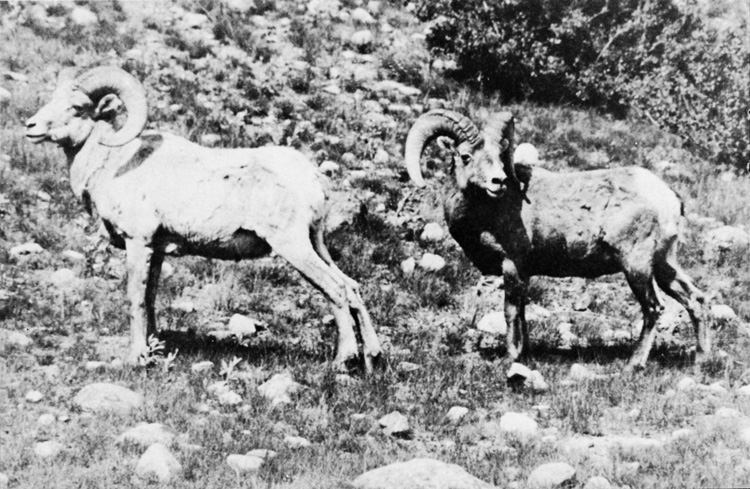
Rocky Mountain National Park
The male bighorn display the horn which have made them famous.
(NPS Photo, from Rocky Mountain National Park Natural History Handbook No. 3)
|
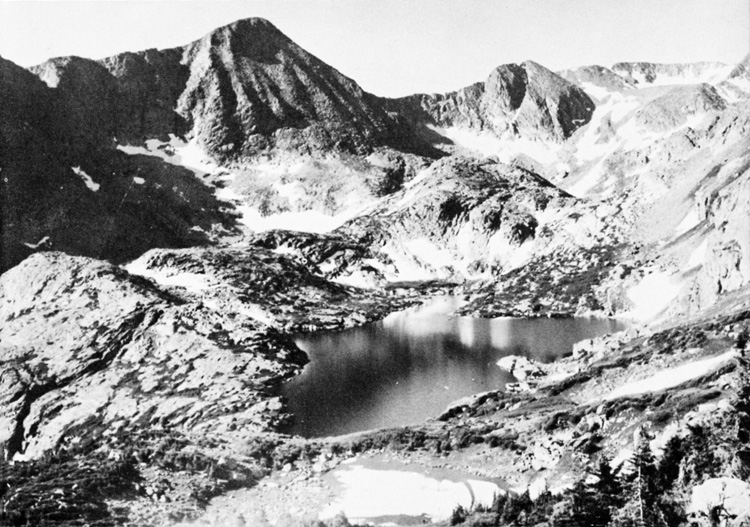
Rocky Mountain National Park
The high mountain lakes are set among the scars of glacier excavation. Arrowhead Lake, in Gorge Lakes Canyon.
(NPS Photo, from Rocky Mountain National Park Natural History Handbook No. 3)
|

The Deserts
(Artwork by Charley Harper)
(click image for a larger size)
|
|
Along the left side, on a black background, white text reads the desert; while
deserts are found from the equator to the polar regions, the best-known American
deserts are in the Nation's southwestern region; among the areas established to
protect such arid landscapes are: Death Valley, Joshua Tree, Organ Pipe Cactus,
and Saguaro National Monuments, and Big Bend National Park; National Park
Service, U.S. Department of the Interior. Starting at top left a band of orange
stretches across the top of the illustration depicting either sunrise or sunset.
Yellow eyes from a small desert animal stare at the viewer. A yellow circle in the
middle top represents the sun. Dark cacti shapes break up the skyline. A green
cactus is in the center of the illustration. Small birds such as red-headed
woodpeckers, hummingbirds, sparrows, and goldfinches are perched around the
cactus or flying around it. In the middle and bottom desert animals are seen
peeking out of burrows in the desert with their yellow eyes facing forward.
|
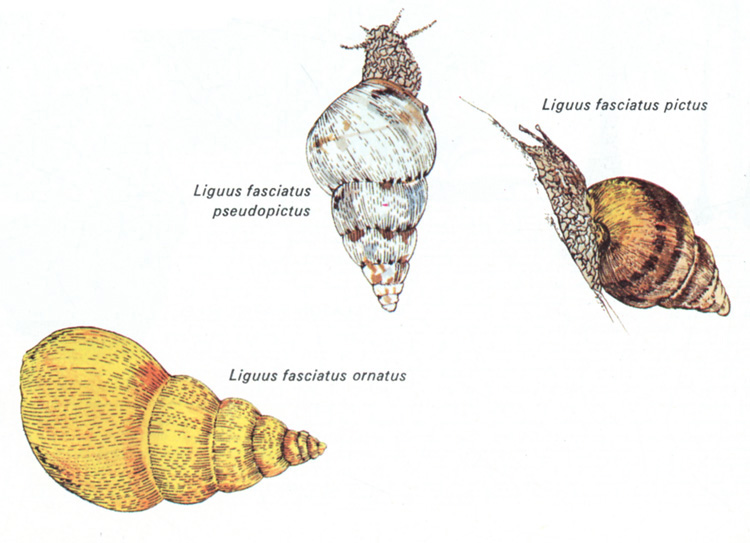
Everglades National Park
There are 52 color forms of Liguus fasciatus (tree snail) found in south Florida.
(Betty Fraser Drawing, from Everglades Wildguide Natural History Series)
|

Canyon Country
(Artwork by Charley Harper)
(click image for a larger size)
|
|
Along the bottom, on a light orange background, white text reads canyon country;
black text reads an enchanted landscape of colorful pinnacles, buttes, spires,
mesas, and canyons teeming with wildlife; National Park Service, U.S. Department
of the Interior; Arizona: Grand Canyon; Nevada/Arizona: Lake Mead; Utah: Arches,
Bryce Canyon, Canyonlands, Capitol Reef, Cedar Breaks, Natural Bridges, Rainbow
Bridge, Zion; Utah/Arizona: Glen Canyon. Starting at top left dark red rectangles
frame the illustration to represent canyon walls. Three small white clouds in bright
blue sky form beneath an orange monarch butterfly. A bighorn sheep looks left
from the top right side. A large red-tailed hawk with his wings splayed faces front
with a red and black-ringed snake clutched in his right talon. Cave drawings are on
the right wall of the canyon while the bottom shows chipmunks, mountain lions,
deer, and rabbits. Cacti and colorful wildflowers can be seen among the canyon
floor along with colorful lizards and birds.
|
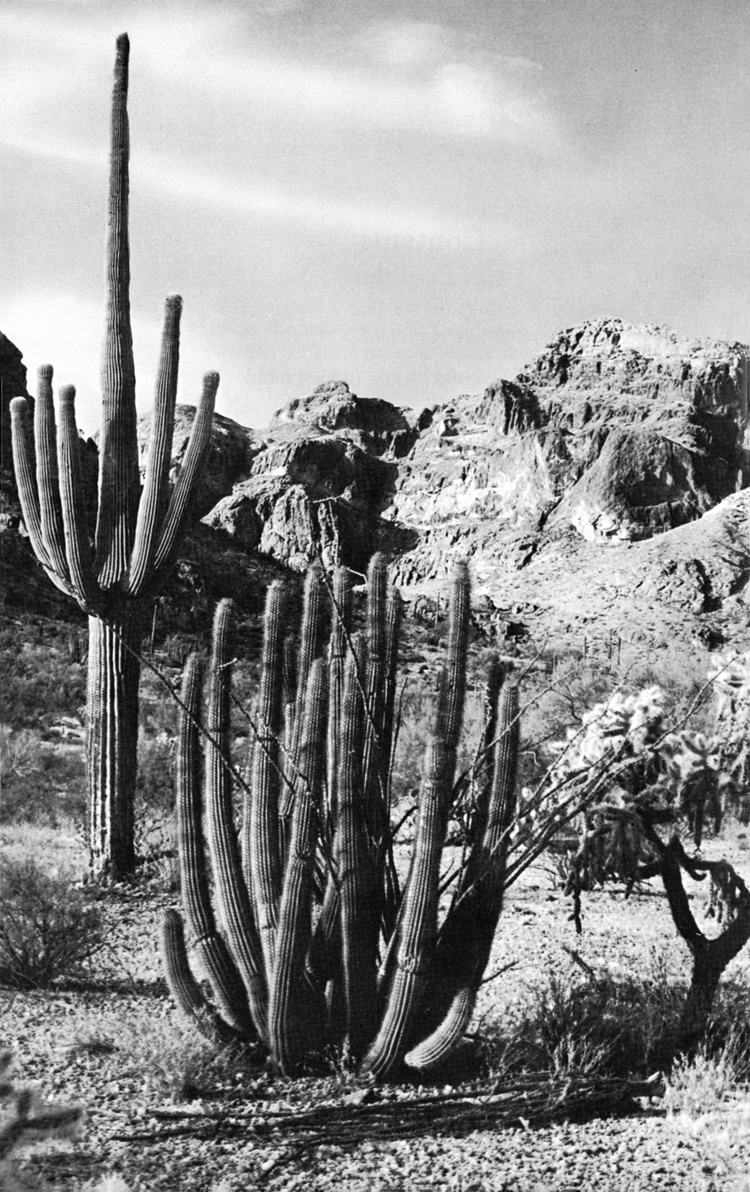
Organ Pipe Cactus National Monument
Saguaro (left), organ pipe cactus (center), jumping cholla cactus (right).
(NPS Photo, from Organ Pipe Cactus National Monument Natural History Handbook No. 6)
|
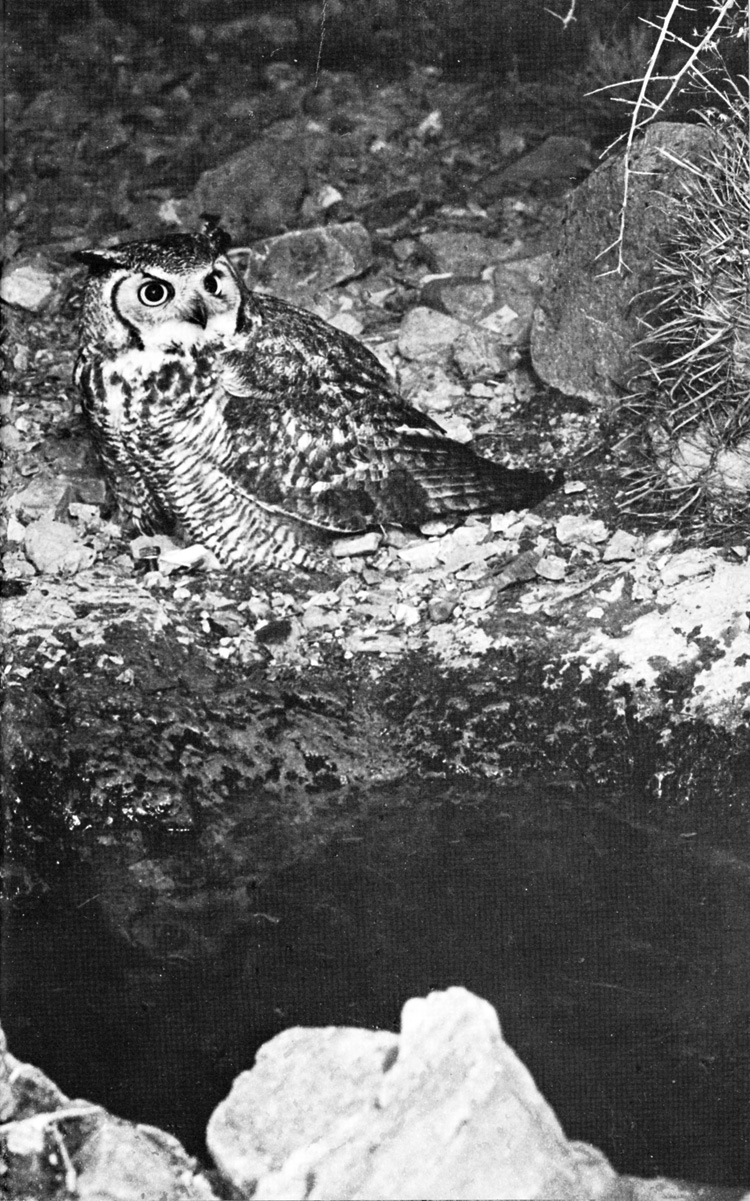
Organ Pipe Cactus National Monument
Great horned owl, shown here by a pool at night, often builds its nest in the forks of a saguaro.
(NPS Photo, from Organ Pipe Cactus National Monument Natural History Handbook No. 6)
|

The Alpine Northwest
(Artwork by Charley Harper)
(click image for a larger size)
|
|
Starting at top left, white text on a lilac background reads The Alpine Northwest,
followed by black text that reads even as the snow begins to melt, Washington
State's mountains burst with an abundance and variety of wildflowers, mammals,
and birds. Just under that, at the top left of the illustration, purple snow-capped
mountains stand behind green snowy mountains. On the mountain, you can see a
black bear and American bald eagle facing left and perching on a bare tree limb.
Multiple birds of muted colors such as gray, pink, and brown birds flying in various
directions. A large rodent holds a white flower at the center of the image. At the
bottom right, there is a collection of wildflowers in white, purple, pink, and green.
On the left bottom half, a stream flows down the mountain. Along the bottom,
black text on a lilac background reads visit Olympic, Mount Rainier, and North
Cascades National Parks; National Park Service, U.S. Department of the Interior.
|
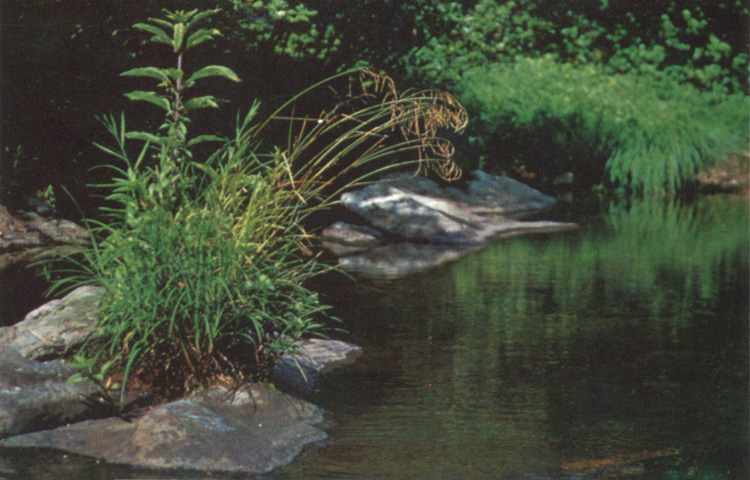
Shenandoah National Park
Big Run's quiet pools are good spots in which to look for wildlife.
(Hugh Crandall Photo, from The Nature of Shenandoah Natural History Series)
|

The Rocky Mountains
(Artwork by Charley Harper)
(click image for a larger size)
|
|
Along the left side, on a bright green background, white text reads the Rocky
Mountains; black text reads a beaver pond reflects the landscape of the Rockies, a
terrain shaped by glaciers, streams, and the beaver itself; visit these wildlife-rich
National Parks: Glacier, Yellowstone, Grand Teton, and Rocky Mountain; National
Park Service, U.S. Department of the Interior. At the top left of the illustration,
vertical green lines of grass hold yellow-dotted aspen leaves, rainbow trough,
yellow and blue wildflowers, an upside-down chipmunk, and a bluebird flying to the
right. Underneath, a large black and white bird flies to the left above a row of
upside-down elk looking at the viewer from over their rumps. More yellow leaves
lead to a green forest with butterflies, yellow and black bird with an orange head,
and pink wildflowers. A large beaver swimming toward the bottom carries a stick in
its mouth, with reflections of snow-capped peaks and a brown bird in the water.
|
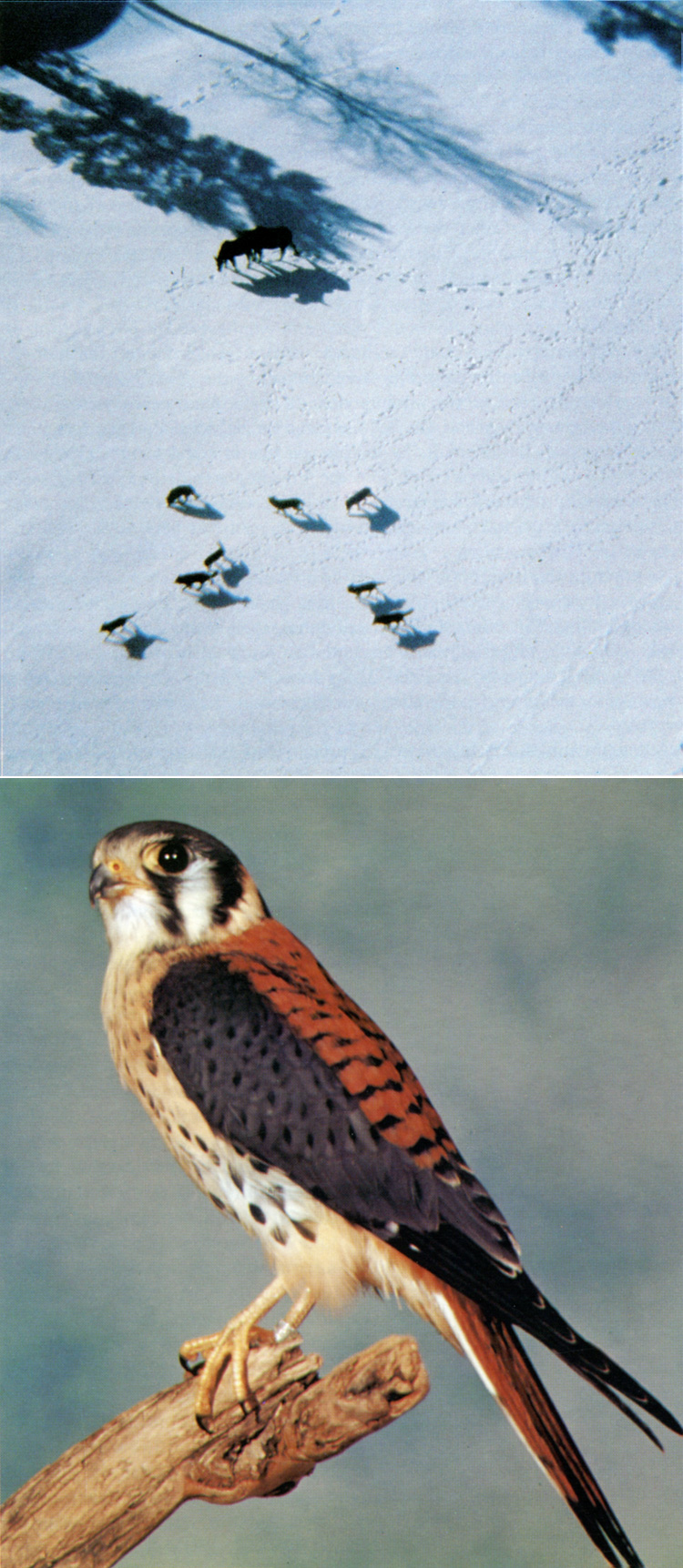
Isle Royale National Park
A wolf pack withdraws after an unsuccessful attack on a cow moose and a yearling (top); sparrow hawk (bottom).
(NPS Photo (top), J. Wiessinger (bottom), from The Life of Isle Royale Natural History Series)
|

Isle Royale
(Artwork by Charley Harper)
(click image for a larger size)
|
|
Along the left side, on a black background, white text reads National Park Service,
U.S. Department of the Interior; Isle Royale; National Park, Michigan. Entire graphic
illustration is covered by a forest of vertical white tree trunks with dark eye spots
on a dark-yellow background of leaves. Four gray wolves travel down toward the
bottom of the illustration while a brown squirrel, woodpeckers, and other birds sit
on limbs or hide behind the trunks and falling yellow and orange leaves. Two large
brown moose lock antlers in the center of the image while a lone orange and black
monarch butterfly flies underneath.
|
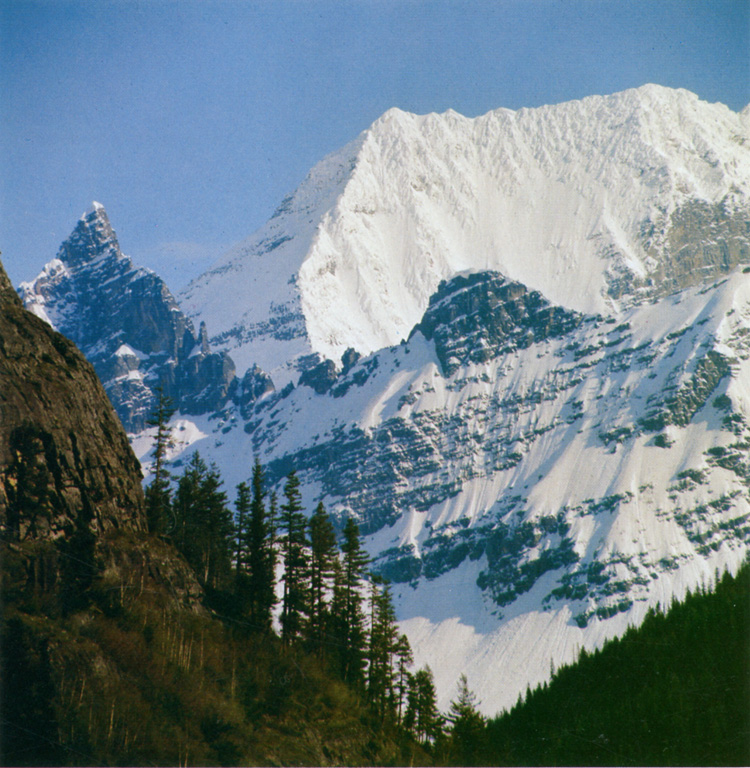
Glacier National Park
The sharp spire of little Matterhorn and the broad face of Mt. Edwards loom above Going-to-the-Sun Road in the upper McDonald Valley. During warm days in spring the valleys of the park resound with the thunder of avalanches.
(from Many-storied Mountains: The Life of Glacier National Park Natural History Series)
|
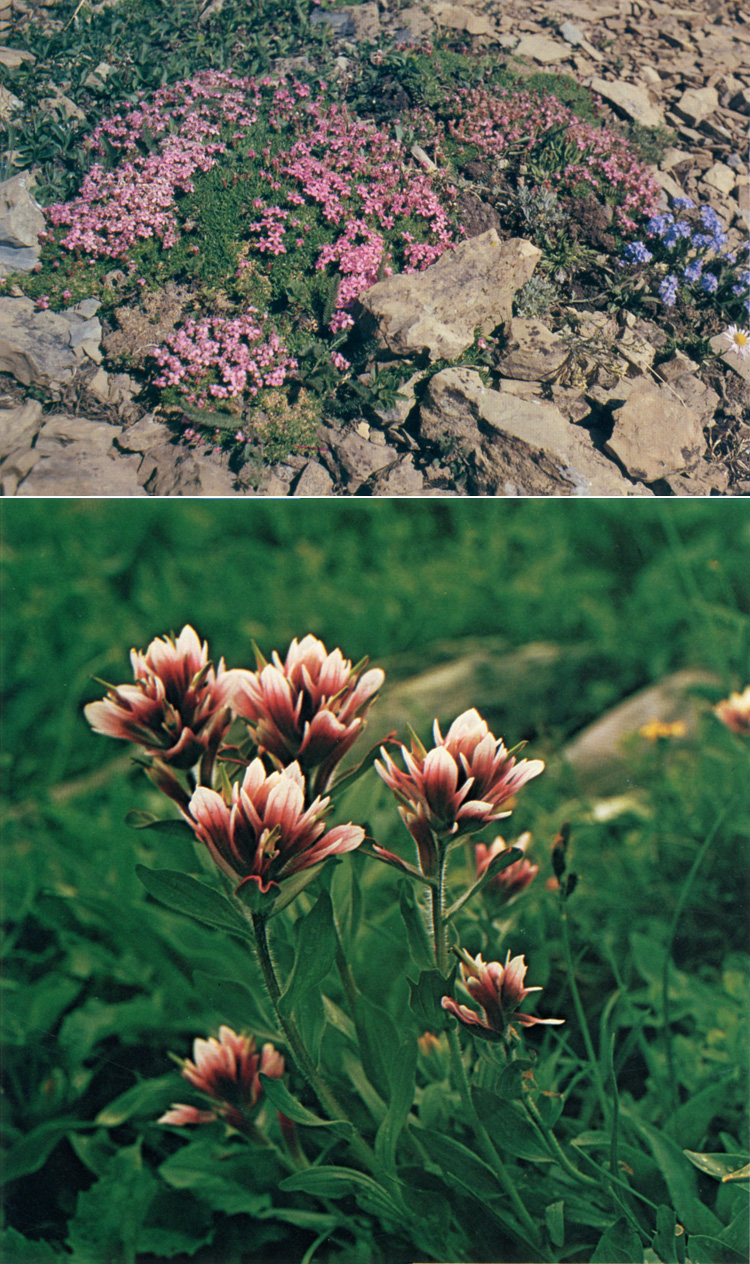
Glacier National Park
Moss campion and mountain forget-me-not (top) colonize a fellfield. Fellfields are rocky alpine sites that are slightly less than 50% bare rock, interspersed with such plant pioneers as cushion plants, mosses, and lichens. Indian paintbrush (bottom) is common at all elevations below tundra. It may be white, yellow, orange, pink or red. The actual flowers, inconspicuous and green, are surrounded by brilliantly colored bracts. Semi-parasitic on other plants, paintbrush is normally found growing in conjunction with other wildflowers; its roots steal sustenance from neighboring plants.
(from Many-storied Mountains: The Life of Glacier National Park Natural History Series)
|
|

